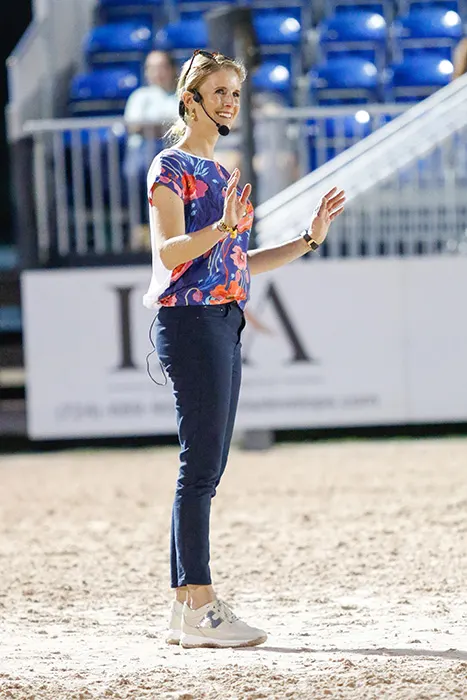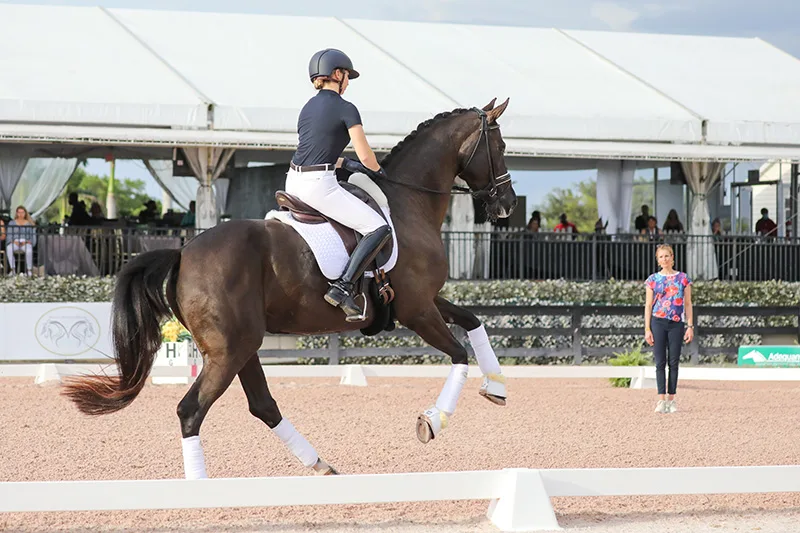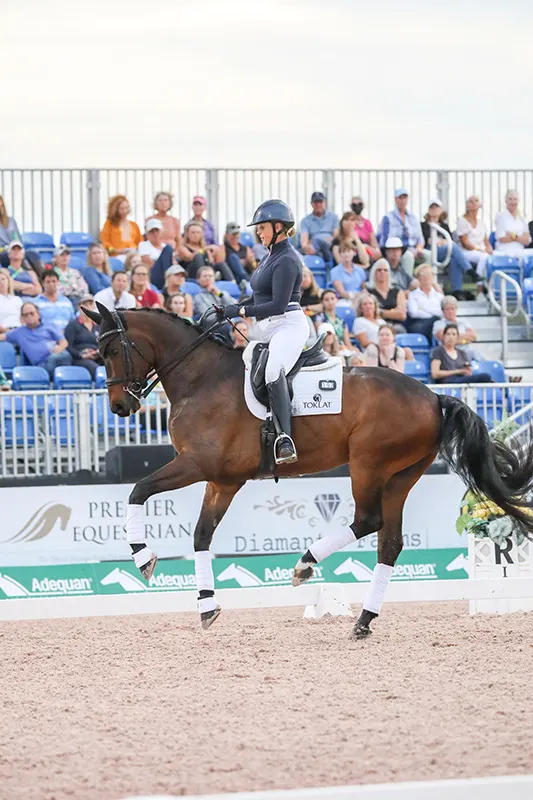Jessica von Bredow-Werndl of Germany is not only an Olympic Games, World Equestrian Games and European Championships gold medalist, she’s also a font of golden nuggets of wisdom when it comes to training horses and their riders.
On her first trip to Wellington, Florida, she was the featured clinician for “An Evening With An Olympic Champion,” held March 24 at the Adequan Global Dressage Festival showgrounds. During the clinic, she worked individually with five riders. While the riders’ training challenges varied, von Bredow-Werndl’s advice repeated consistent themes throughout.
“It’s important to remind ourselves why we do this sport,” she said. “It’s because we love the horses. It’s important to enjoy the journey with them, to look after our horses and to have fun. Also, the horses should enjoy the journey. I invite you to really enjoy what you are doing together with your horses.”

Tokyo Olympic gold medalist Jessica von Bredow-Werndl, who also has won gold at the World and European Championships, shared her training insights during “An Evening With An Olympic Champion,” held March 24 at the Adequan Global Dressage Festival grounds in Wellington, Fla. Sue Weakley Photos
As she guided the riders through their exercises, she repeated several key points:
• Talk with your horse. Praise him. Celebrate him so he wants to do more. This is the best key to motivation. Riders have to give the horse a reason to work hard for them. The voice helps them gain confidence. Some horses are so sensitive to the bit and in the mouth that it can be negative if the rider pats them too much with the hand, and some are behind the bit so throwing away the reins to pat them also is not comfortable for them.
• Take lots of walk breaks, not only so the horse can think about the training, but so both rider and horse can breathe. If the horses don’t know they will get regular breaks, there’s no reason for them to give their best effort during the work.
• Take your time.
• Have fun. She often told the riders to make their horses more extroverted or “more cheeky.” She said it was important for the horse to be cheeky and to encourage them to show their personalities; if a rider suppresses them, they can’t come out of themselves. To show well in competition, they need self-confidence.
• Prioritize harmony and balance, for horse and rider alike. The horse needs to build physical strength, but mental balance is also important. Von Bredow-Werndl doesn’t train her horses more than two or three days in a row without a break, she said. She hacks them one to two days a week.
“We want them to give their very best, but it’s our job to make them live the best life they can do,” she said. “Therefore, it’s also very important for me not to overtrain them, that they have mental balance, that they can go out in the field every day, that they hang out with the horses, and also after competitions or training that they have enough time to recover. And this is really cool because when you listen to your horses and when you get to know your horses, they start talking to you. It’s not that easy in the beginning, especially not when you have a new horse and you haven’t worked the horse so long, but it’s so cool to see them tell you what they want, what they need.”
Warming Up
Hannah Beaulieu, of Wellington, and Siri, her own 6-year-old Oldenburg mare (Dante Weltino—Sanrubina, Sandro Hit) were first to go. Beaulieu worked with von Bredow-Werndl in Germany for two years, so she already knew the warm-up routine.
From the very beginning of the ride, von Bredow-Werndl wanted Siri to be using her hind legs.
“For me, it makes no sense for the horse to be long and low in the neck in the warm-up and then tell them ‘No, no and now you use your body differently,’ ” she said. “If you warm up and then you ask for different stuff and you have to concentrate, we’re too late. They’re too tight.
“Try to keep the reins as long as possible, but the neck doesn’t need to be low. It’s not about the expression in the beginning; it’s about the balance. Take your time. I think it’s very important to warm up as short as possible but as long as necessary.”
A ‘Super’ Exercise For Flying Changes
Beaulieu and Siri worked on perfecting flying changes. First, von Bredow-Werndl told Beaulieu to imagine she was sitting on an airplane taking off. She was instructed to take her weight behind the saddle so the mare would learn to carry more weight on the hind legs.

Hannah Beaulieu and Siri put into practice von Bredow-Werndl’s visualization of an airplane taking off.
She had the pair use an exercise to teach the flying change she called her very favorite.
ADVERTISEMENT
“This is a super exercise because some horses know there is coming a flying change, and then they run away,” von Bredow-Werndl said. “It’s very easy to keep the horses waiting for it.”
Cantering on the right lead, preparing for a change to the left, she asked Beaulieu to collect the stride and, as she collected, bend the mare a little bit using her outside (left) leg. She then made a 10-meter half circle to the right and tried to bring all the horse’s energy to her hind legs, thinking almost of making a quarter pirouette, to create a small, active canter. As the horse got to the center line, she leg yielded a little bit to the left to prepare for the change, the new bend and the new direction. Doing this also got the horse onto the outside rein. Von Bredow-Werndl then instructed her to wait until the stride and “bounce” felt good before asking for the change.
“When she feels ready, when she feels she is waiting for your aid, you give the aid. Try to turn her by bending her slowly more and more around your outside leg.”
If it doesn’t work out or the rider feels the moment is wrong, they can always circle and turn back around with no lead change and try again, she noted.
Carrying Himself
British born Louisa-Marcelle Eadie of Sherman, Connecticut, and Elan de Cheney, an 8-year-old Trotteur Français (Kerido Du Donjon—Quoralie de Chenu) gelding owned by Chansonette Farm LLC, were next up. They worked on getting the horse to carry himself instead of having Eadie take on the weight.
She was instructed to ride him in a canter using transitions within the gait while placing his shoulder a little to the inside as she rode forward, then using haunches-in when she took him back.
“I want you to give rein. Don’t carry him; don’t carry his head,” von Bredow-Werndl instructed.
The pair toggled between shoulder-in, shoulder-out and haunches-in as well as tempo transitions. She cautioned Eadie to concentrate on using the snaffle and backing off on the curb bit in the double bridle to encourage him to carry himself.

Von Bredow-Werndl instructed Louisa Eadie to “sit deep” and soften the curb rein to encourage Elan du Cheney to push from behind and carry himself.
They took the quarter line, half-passed to the right and then did a shoulder-in to the right followed by a shoulder-in to the left before the flying change. Von Bredow-Werndl reminded the audience to do the shoulder-in with the outside rein rather than pulling on the inside rein, and to do haunches-in using the outside leg. She reminded Eadie to sit back.
“When you want him to do uphill changes, you have to sit like it,” von Bredow-Werndl said. “When you sit up, you press him down in the front. Remember the starting airplane? It’s my favorite picture. Remember how to sit when you prepare the change. Sit deep.”
Hot Horse To Cool Changes
Emily Donaldson, Parkesburg, Pennsylvania, and her own 13-year-old Hanoverian gelding Beaujolais 75 (Bugatti Hilltop—Conflora, Contucci) were in the middle of the line-up.
Donaldson’s challenge with the flying changes is that her horse gets excited and wants to run off after doing them. To address the issue, von Bredow-Werndl had the pair focus on single flying changes instead of tempi changes. To counter the gelding’s tendency to run away after a change, she asked Donaldson to do serpentines or little circles immediately after the change.

Praise and work breaks were high on von Bredow-Werndl’s list of ingredients for success, as demonstrated here with Emily Donaldson and Beaujolais 75.
“Do a quarter pirouette, make him round around your new inside leg, change, and make him circle again to signal [to] him to stay on his hind legs,” von Bredow-Werndl said. “Don’t pull back with your hand and give up control with the front. Focus on the hind legs because what he is doing is he’s running away from the hind legs. Open the hand so there can’t be too much tension. If you want it easier and for him to be more confident, you have to train it without your hands [so] that he listens more to your core.”
During a walk break, the gold medalist continued. “I like to compare horses to highly intelligent children. When they don’t understand what we are asking for, we have to look for different ways to explain ourselves because the horses always want to do it right. There are horses, even more sensitive ones, where it takes a bit longer but it’s so important to look for different ways to explain what we want. The horses don’t want to make mistakes. They always want to please us.”
Half-Pass Zigzag
Next up was Kristina Harrison-Antell, Los Angeles, and Jocelyn Towne’s I Felix, a 9-year-old Dutch Warmblood gelding (Fidertanz—Dalwhinnie, UB40). They worked on the canter half-pass zigzag.
ADVERTISEMENT
Von Bredow-Werndl reminded Antell to sit deep so the gelding could become more active with his hind legs.
“If you want him to become more active from behind, you need to make a space for it.”
They prepared by working in collected canter, which was already well-balanced, to shoulder-in, then onto haunches-in to help him to understand he should come under with his inside leg.
“I usually prepare the flying change with my leg followed by the half-halt to say the aid is coming,” von Bredow-Werndl said. “What is also very important is that he looks at the point where he is riding to and [for you] to sit as much behind that he can still move your hips to the front during the change. If you focus on being straight, it’s still important not to be stiff but to move with his motion, with his change. Try to think of the airplane as you do the change. Give him space in the front.”
For the zigzag half-pass, they did a half-pass to the left, then a shoulder-in to the right, followed by a flying change and they kept the shoulder-in to the right. This exercise helps horses who tend to jump to the new inside leg in the zigzag, von Bredow-Werndl said.
“When you train the zigzag too much, the horses tend to jump into the new direction after giving the aid for the flying change,” she said. “With the single flying change, try to sit back and give the forward movement with your hip. Not sideways. Lift him into the front. Sit back.”
Pirouettes And Piaffe
The final rider was Ali Potasky of Versailles, Kentucky, along with INXS, her own 9-year-old Dutch Warmblood gelding (Everdale—Whinca, Rosseau). They worked on pirouettes to get control of the horse’s hind legs as well as the shoulders.
Von Bredow-Werndl explained her training philosophy: “When I teach the horses the pirouettes, I love to do it in the walk and to do a shoulder-in to activate the inside hind leg of my horse. When this works, take the shoulder out to kind of haunches-in. Also the focus is on the inside hind leg of the horse . . . to keep the inside hind leg under.”
The rider also should be able to control the shoulder. “When you take the shoulder to the inside, it’s OK to push the hind legs to the outside because you want a reaction from his inside hind leg,” she said.
Potasky was reminded to sit to the inside during the exercise so that the horse could balance himself. When Potasky was ready to canter, von Bredow-Werndl directed her to remind her horse to use his inside hind leg to go forward, then sideways, then forward, then sideways.
The pair also worked on their piaffe. Von Bredow-Werndl teaches the piaffe before the passage and she starts in hand before adding a rider in a playful and forward-moving way.
Potasky was directed to trot, then to do a piaffe transition, and she was reminded to activate the gelding from behind before the half-halt.
“Try to do to it without your hand. Stretch your body. Before he gets too slow, move on because the rhythm of the piaffe is the rhythm of the trot. Take a few steps on the spot, or a little forward at first, and then back to the trot. Then more active but not many steps. We want the expression from a loose contact.”
As usual, the rider was told to connect with her horse and to make him more cheeky.
“Talk to him. Praise him,” von Bredow-Werndl encouraged. “Transition to piaffe without taking back from your hand. Try to make it more cheeky and that he comes a little bit out of himself. All the energy he has when he is going forward, you should try to bring it into the hind legs when you bring him back. You want his withers to lift to give more space for his hind legs to come under. Try to get all the energy in the hind legs.
As they finished the lesson, INXS didn’t want to wind down. “Try to finish how we started,” von Bredow-Werndl said. “Talk to him. Wait for him. Slow down. Praise him.”
As the stands emptied, the Olympian kept teaching; she had lots more nuggets to share.
















